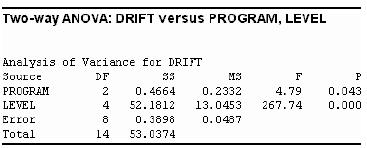A commonly used index to estimate the reliability of a building subjected to lateral loads is the
Question:
A commonly used index to estimate the reliability of a building subjected to lateral loads is the drift ratio. Sophisticated computer programs such as STAAD-III have been developed to estimate the drift ratio based on variables such as beam stiffness, column stiffness, story height, moment of inertia, and so on. Civil engineers at the State University of New York at Buffalo and the University of Central Florida performed an experiment to compare drift ratio estimates using STAAD-III with the estimates produced by a new, simpler microcomputer program called DRIFT (Microcomputers in Civil Engineering, 1993). Data for a 21-story building were used as input to the programs. Two runs were made with STAADIII: Run 1 considered axial deformation of the building columns, and run 2 neglected this information. The goal of the analysis is to compare the mean drift ratios (where drift is measured as lateral displacement) estimated by the three computer runs (the two STAAD-III runs and DRIFT). The lateral displacements (in inches) estimated by the three programs are recorded in the next table for each of five building levels (1, 5, 10, 15, and 21). A MINITAB printout of the analysis of variance for the data is shown above.

a. Identify the treatments in the experiment.
b. Because lateral displacement will vary greatly across building levels (floors), a randomized block design will be used to reduce the level-to-level variation in drift. Explain, diagrammatically, the setup of the design if all 21 levels are to be included in the study.
c. Using the information in the printout, compare the mean drift ratios estimated by the three programs.

Step by Step Answer:

Statistics For Engineering And The Sciences
ISBN: 9781498728850
6th Edition
Authors: William M. Mendenhall, Terry L. Sincich





